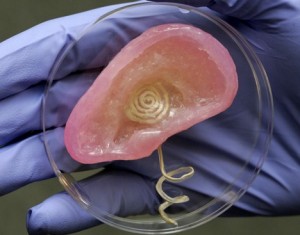The importance of bioprinting cannot be overstated, as it holds greats potential to unlock incredible advancements in the medical science but also to provide access to affordable health care and provision to war-ravaged and economically underdeveloped countries.

Image credit: flickr User: PTB2011
The development of 3D printing and its capabilities will play an invaluable part in our lives, whether by producing prosthetic limbs or customized fully-working organs. But how does the process of creating human tissue through 3D printers actually work?
UK-based Printerlnks and US startup company Organovo have joined forces to create a visual guide to the subject.
According to the article on the Telegraph, 3D printed tissue is created by using modified printer cartridges and extracted cells, sourced from patient biopsies with respect to examining cancer cells or stem cells. The cells are grown using standard techniques and cultured in a growth medium in dishes, enabling them to multiply.
Once they have grown, the cells are collected and formed into spheroids or other shapes and loaded into a cartridge to create Biolnk, which is loaded into a NovoGen MMX bioprinter along with a cartridge of Hydrogel.
The printer then prints a layer of the water-based gel, followed by a layer of Biolnk cells, and so on. After the necessary amount of layers has been printed, the printed tissue is left to grow as a structure, and the hydrogel is removed.
At this point, scientists use printed tissues for medical research. They introduce disease to the tissue and monitor its reaction. In the future, it is more than likely that 3D printers will be used to create simple tissues for implanting into current organs and partial organs, with printing of full organs expected to become reality in the next decade or so.
Based on previous experiments and experiences, Organovo estimates it would currently take 10 days to print an average-sized liver and lobe, but the required time to 3D print an organ will likely decrease as the technology advances.
However, the advancement of the technology and its application for medical purposes has surfaced moral and ethical concerns over the quality of the organs and the entities that would control the right to produce them. Some argue that 3D printing human components further eradicates the line between man and machine, giving us the right to “play God” on an unprecedented scale.
Be that as it may, there is no denying that bioprinting has the potential to revolutionize medicine and healthcare beyond what was deemed possible only a short while ago.



















